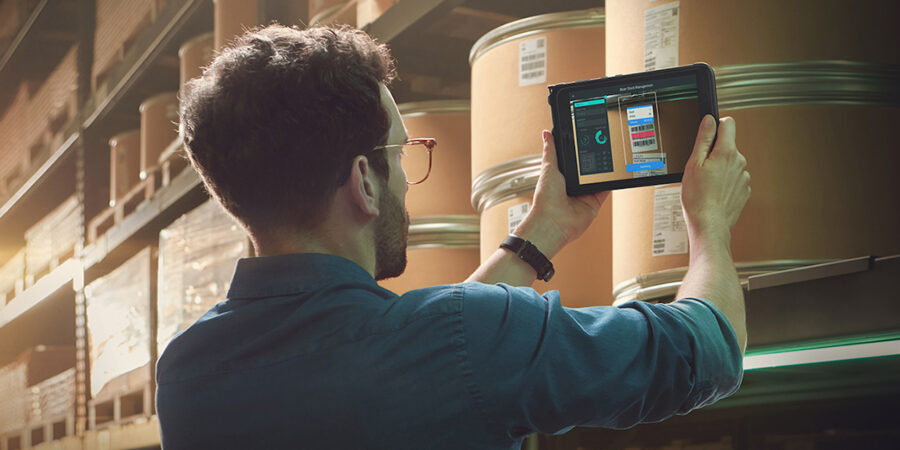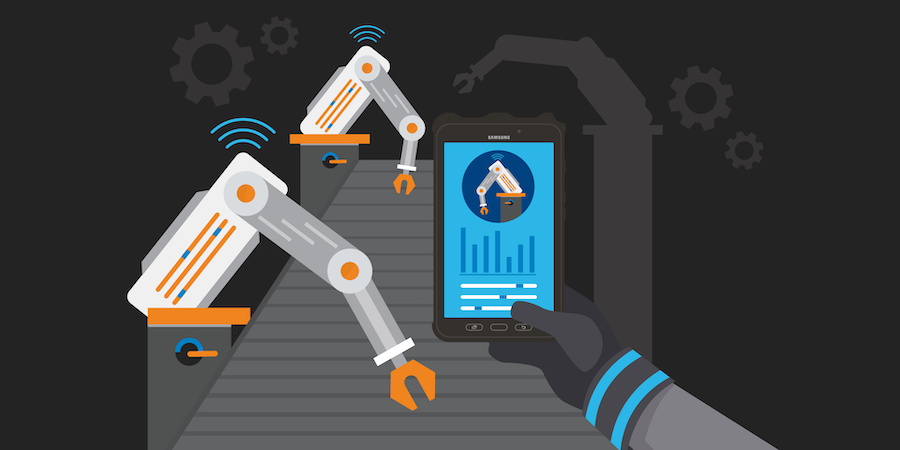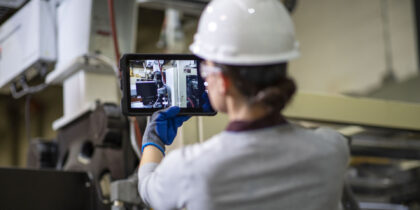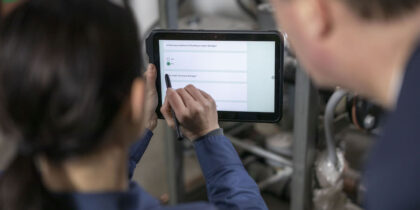Market demand is on an upward trajectory heading into 2022, and manufacturers around the globe are looking for innovative ways to meet this demand amid ongoing labor shortages. There’s no choice but to double down on adopting new technologies, systems and automated solutions that allow for more efficient production and distribution.
Among these solutions is the smart factory, outfitted with digitization and computer technologies like artificial intelligence (AI) that optimize the use of all available resources — including people, equipment and materials — to make products as quickly and efficiently as possible.
Industry 4.0, also referred to as Manufacturing 4.0 or the fourth industrial revolution, is all about smart factories, the new trend in the world of manufacturing. It’s also a nod to the collaboration of today’s diverse technologies, including the industrial internet of things (IIoT) and the cloud, as well as human-enabled technology like rugged mobile devices on manufacturing floors and assembly lines. Working in unison, these innovative solutions are the foundation of manufacturing moving forward.
Here are three trends that will help push the manufacturing industry forward in 2022:
1. Industry 4.0
Companies have always invested in technology to reduce their labor inputs, often the most expensive portion of the cost of goods. But now, this labor reduction is not so much about cost reduction, as it is a necessary response to labor shortages. Manufacturers cannot hire enough workers to meet increasing demand or replace these workers fast enough when they leave.
In addition to direct automation — where machines assist or replace people on the plant floor — newer automation technologies increase worker efficiency by distributing the latest information and instructions in real time while collecting activity data automatically. This super-charged flow of information is essential to the analytical engines, which turn this information into valuable, actionable intelligence such as up-to-date schedules, instructions and status reports.
As factories become increasingly digital, they also become a more integrated part of the overall supply chain. Full product descriptions and engineering information are available throughout the manufacturing process — and in the supply chain as well — so all documentation is at hand, consistent and up-to-date. This readily available information and technical data better inform product performance measurements, customer support and product improvement efforts. The descriptions are now so comprehensive, in fact, that companies have come to refer to a product’s “digital twin” — everything about its design, makeup, production, use, maintenance and performance to the extent that it actually exists in the digital world. Engineers, designers, developers and others along the supply chain can exercise this digital twin, modify it, try alternative production techniques and “run” it in cyberspace to see how it works and how it might perform in other conditions or with other modifications.
2. Industrial internet of things (IIoT)
The human-machine interface (HMI) is a critical element of this enhanced data flow. The connection to the systems must be ubiquitous (available everywhere, all the time), convenient (not require the worker to stop working or leave the workstation) and valuable (based on accurate and up-to-date data). This is where the hardware comes into play. The modern digital factory relies on sensors, vision systems, connectivity (networks) and HMI devices like wearables, voice response and especially mobile devices, which are often the link between people and digital systems.
Smartphones and other consumer mobile devices have spurred a veritable revolution in the development of small, connected, low-cost sensors, which have found their way onto the factory floor and throughout the supply chain. Generically referred to as the IIoT, these sensors capture data from the production line, the plant, the warehouse, shipments en route (for example, tracking temperature and pressure of sensitive cargo) and even out in the field after sale and installation. The data is fed through cellular networks and the internet back to the manufacturing site, where design, engineering, quality control, customer service and other teams use this data to make better-informed decisions.
3. Augmented reality (AR)
At this point, most everybody has heard of virtual reality (VR), digital environments where people can interact with 4D games, training modules and other challenges or adventures. In the industrial world, augmented reality (AR) is even more important because it ties together the digital and physical worlds. An AR device necessarily includes a camera. When aimed at an appropriate subject, such as a product, machine or work area, the device add a digital overlay to the item on the display. This overlay might include work instructions and illustrations that lead the worker through a procedure, for example, to assemble, repair or disassemble the item.
Modernize your factory with mobile
Get your free guide to the mobile technologies that will accelerate your smart factory journey. Download Now
AR tools can reduce training time, ensure that proper procedures are followed, provide instant information access — with little to no process disruption — and improve worker satisfaction by making their jobs easier and less stressful. The visual documentation allows for quicker comprehension than plain text, and lowers the chance of information getting lost in translation.
Paper-based instructions and manuals are often difficult to manage and distribute. And they often remain in circulation after they’ve become obsolete, whereas digital solutions drawn from a single data source are always up-to-date, available anywhere and everywhere and far easier to keep track of.
Onward with digital manufacturing
Increased automation is a long-term trend that is becoming ever more important as new technologies emerge. Digitization and smart factory evolution may be still in their infancy but are already revolutionizing manufacturing and promise to bring factories to whole new levels of efficiency, flexibility, and performance. And these tools are reaching new levels of maturity just when they are needed most to optimize the use of scarce resources and enable factories to increase production in the face of increasing demand in a difficult labor market.
As companies expand their use of Industry 4.0 tools and facilities — ubiquitous data flow, full integration, IIoT, AR and smart systems, throughput and productivity will increase because all available resources will be focused on the tasks at hand — producing, distributing and supporting the products in the most efficient way possible. Worker satisfaction will increase as many of the burdensome reporting and documentation tasks become automated.
Fortunately, some U.S. manufacturers will likely be able to take advantage of funding included in the new U.S. infrastructure bill, which they could use to upgrade their equipment and invest in technology solutions for plant productivity and connectivity. Supported by the IIoT, Industry 4.0 and innovative software like AR, automated and mobile-enabled manufacturing solutions will be what allows the sector to meet market demand and continue growing at breakneck speed in 2022.
Learn more about the mobile technologies that will accelerate your smart factory journey in this free guide. And if you’re not sure what will work best for your team, explore Samsung’s full lineup of versatile digital manufacturing solutions.








